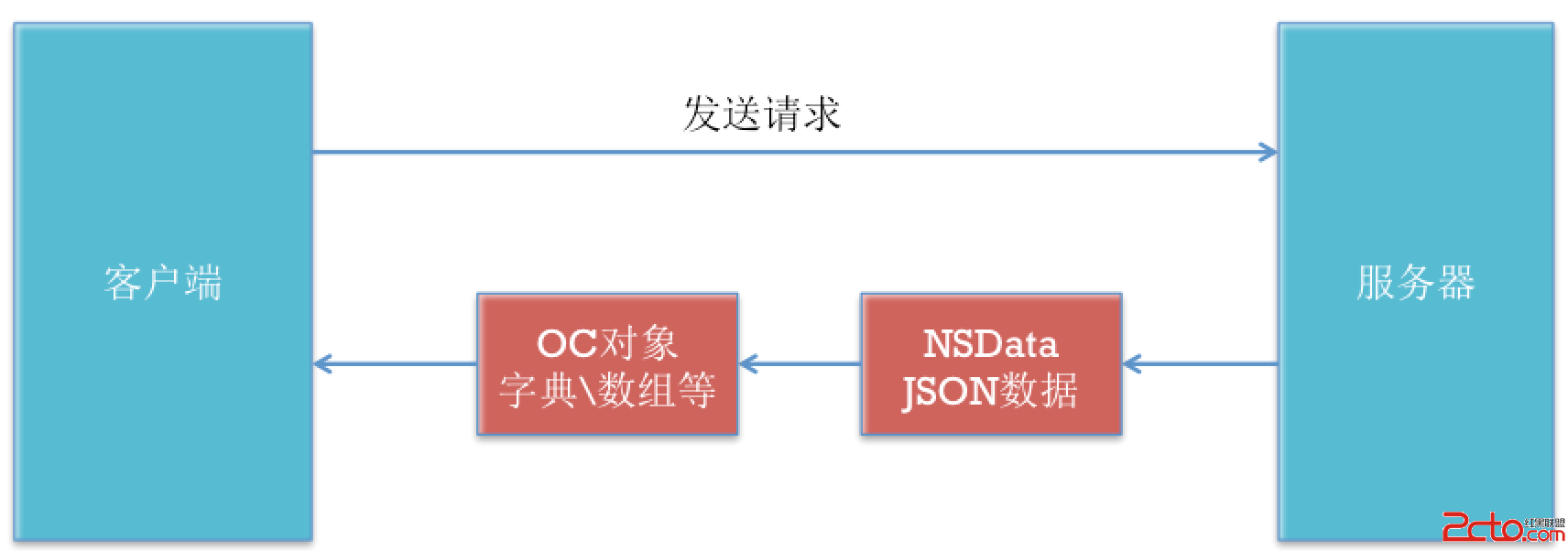iOS開發 - JSON解析
編輯:IOS開發綜合
JSON解析
什麼是JSON
JSON是一種輕量級的數據格式,一般用於數據交互
服務器返回給客戶端的數據,一般都是JSON格式或者XML格式(文件下載除外)
JSON的格式很像OC中的字典和數組
{"name" : "jack", "age" : 10}
{"names" : ["jack", "rose", "jim"]}
標准JSON格式的注意點:key必須用雙引號
要想從JSON中挖掘出具體數據,得對JSON進行解析
JSON 轉換為 OC數據類型
JSON – OC 轉換對照表
JSON解析方案
在iOS中,JSON的常見解析方案有4種
第三方框架:JSONKit、SBJson、TouchJSON(性能從左到右,越差)
蘋果原生(自帶):NSJSONSerialization(性能最好)
NSJSONSerialization的常見方法
//JSON數據 到 OC對象
+ (id)JSONObjectWithData:(NSData *)data options:(NSJSONReadingOptions)opt error:(NSError **)error;
//OC對象 到 JSON數據
+ (NSData *)dataWithJSONObject:(id)obj options:(NSJSONWritingOptions)opt error:(NSError **)error;
解析來自服務器的JSON

JSON解析實例
@interface ViewController ()
@property (weak, nonatomic) IBOutlet UITextField *username;
@property (weak, nonatomic) IBOutlet UITextField *pwd;
- (IBAction)login;
@end
@implementation ViewController
- (void)viewDidLoad
{
[super viewDidLoad];
// Do any additional setup after loading the view, typically from a nib.
}
- (void)touchesBegan:(NSSet *)touches withEvent:(UIEvent *)event
{
[self.view endEditing:YES];
}
- (IBAction)login {
// 1.用戶名
NSString *usernameText = self.username.text;
if (usernameText.length == 0) {
[MBProgressHUD showError:@"請輸入用戶名"];
return;
}
// 2.密碼
NSString *pwdText = self.pwd.text;
if (pwdText.length == 0) {
[MBProgressHUD showError:@"請輸入密碼"];
return;
}
// 3.發送用戶名和密碼給服務器(走HTTP協議)
// 創建一個URL : 請求路徑
NSString *urlStr = [NSString stringWithFormat:@"http://localhost:8080/Server/login?username=%@&pwd=%@",usernameText, pwdText];
NSURL *url = [NSURL URLWithString:urlStr];
// 創建一個請求
NSURLRequest *request = [NSURLRequest requestWithURL:url];
// NSLog(@"begin---");
// 發送一個同步請求(在主線程發送請求)
// queue :存放completionHandler這個任務
NSOperationQueue *queue = [NSOperationQueue mainQueue];
[NSURLConnection sendAsynchronousRequest:request queue:queue completionHandler:
^(NSURLResponse *response, NSData *data, NSError *connectionError) {
// 這個block會在請求完畢的時候自動調用
if (connectionError || data == nil) {
[MBProgressHUD showError:@"請求失敗"];
return;
}
// 解析服務器返回的JSON數據
NSDictionary *dict = [NSJSONSerialization JSONObjectWithData:data options:NSJSONReadingMutableLeaves error:nil];
NSString *error = dict[@"error"];
if (error) {
// {"error":"用戶名不存在"}
// {"error":"密碼不正確"}
[MBProgressHUD showError:error];
} else {
// {"success":"登錄成功"}
NSString *success = dict[@"success"];
[MBProgressHUD showSuccess:success];
}
}];
// NSLog(@"end---");
}
@end
視屏JSON數據解析實例
模型類
#import
@interface Video : NSObject
/**
* ID
*/
@property (nonatomic, assign) int id;
/**
* 時長
*/
@property (nonatomic, assign) int length;
/**
* 圖片(視頻截圖)
*/
@property (nonatomic, copy) NSString *image;
/**
* 視頻名字
*/
@property (nonatomic, copy) NSString *name;
/**
* 視頻的播放路徑
*/
@property (nonatomic, copy) NSString *url;
+ (instancetype)videoWithDict:(NSDictionary *)dict;
@end
#import "Video.h"
@implementation Video
+ (instancetype)videoWithDict:(NSDictionary *)dict
{
Video *video = [[self alloc] init];
[video setValuesForKeysWithDictionary:dict];
return video;
}
@end
#import
#define Url(path) [NSURL URLWithString:[NSString stringWithFormat:@"http://localhost:8080/Server/%@", path]]
@interface VideosViewController ()
@property (nonatomic, strong) NSMutableArray *videos;
@end
@implementation VideosViewController
- (NSMutableArray *)videos
{
if (!_videos) {
self.videos = [[NSMutableArray alloc] init];
}
return _videos;
}
- (void)viewDidLoad
{
[super viewDidLoad];
/**
加載服務器最新的視頻信息
*/
// 1.創建URL
NSURL *url = Url(@"video");
// 2.創建請求
NSURLRequest *request = [NSURLRequest requestWithURL:url];
// 3.發送請求
[NSURLConnection sendAsynchronousRequest:request queue:[NSOperationQueue mainQueue] completionHandler:^(NSURLResponse *response, NSData *data, NSError *connectionError) {
if (connectionError || data == nil) {
[MBProgressHUD showError:@"網絡繁忙,請稍後再試!"];
return;
}
// 解析JSON數據
NSDictionary *dict = [NSJSONSerialization JSONObjectWithData:data options:NSJSONReadingMutableLeaves error:nil];
NSArray *videoArray = dict[@"videos"];
for (NSDictionary *videoDict in videoArray) {
HMVideo *video = [HMVideo videoWithDict:videoDict];
[self.videos addObject:video];
}
// 刷新表格
[self.tableView reloadData];
}];
}
#pragma mark - Table view data source
- (NSInteger)tableView:(UITableView *)tableView numberOfRowsInSection:(NSInteger)section
{
return self.videos.count;
}
- (UITableViewCell *)tableView:(UITableView *)tableView cellForRowAtIndexPath:(NSIndexPath *)indexPath
{
static NSString *ID = @"video";
UITableViewCell *cell = [tableView dequeueReusableCellWithIdentifier:ID];
if (!cell) {
cell = [[UITableViewCell alloc] initWithStyle:UITableViewCellStyleSubtitle reuseIdentifier:ID];
}
HMVideo *video = self.videos[indexPath.row];
cell.textLabel.text = video.name;
cell.detailTextLabel.text = [NSString stringWithFormat:@"時長 : %d 分鐘", video.length];
// 顯示視頻截圖
NSURL *url = HMUrl(video.image);
[cell.imageView sd_setImageWithURL:url placeholderImage:[UIImage imageNamed:@"placehoder"]];
return cell;
}
#pragma mark - 代理方法
- (void)tableView:(UITableView *)tableView didSelectRowAtIndexPath:(NSIndexPath *)indexPath
{
// 1.取出對應的視頻模型
HMVideo *video = self.videos[indexPath.row];
// 2.創建系統自帶的視頻播放控制器
NSURL *url = Url(video.url);
MPMoviePlayerViewController *playerVc = [[MPMoviePlayerViewController alloc] initWithContentURL:url];
// 3.顯示播放器
[self presentViewController:playerVc animated:YES completion:nil];
}
@end
相關文章
+



